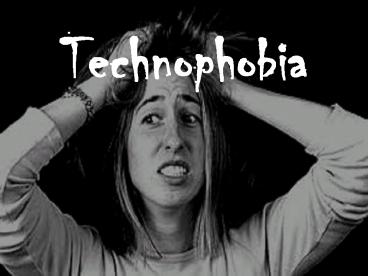Technophobia - PowerPoint PPT Presentation
1 / 18
Title:
Technophobia
Description:
It is exemplified in popular culture and thinking through movies such as ... ( Wikepedia) Most real-life examples of Technophobia are far more sedate, from fear of ... – PowerPoint PPT presentation
Number of Views:534
Avg rating:3.0/5.0
Title: Technophobia
1
Technophobia
2
- Technophobia is the fear of modern technology and
is the opposite of technophilia. It is
exemplified in popular culture and thinking
through movies such as Terminator 2 Judgment Day
and going back to the book Frankenstein by Mary
Shelly. (Wikepedia)
3
- Most real-life examples of Technophobia are far
more sedate, from fear of learning to use a
computer to choosing to withdraw cash from a
human bank cashier rather than from the Hole in
the Wall (ATM).
4
What are the symptoms of Technophobia ?
5
What are the symptoms of Technophobia ?
- Breathlessness
- Dizziness
- Excessive perspiration
- Nausea
- Dry mouth
- Shaking
- Heart palpitations
- Inability to speak or think clearly
- Becoming angry or losing control
- Sensation of detachment from reality
- Full blown anxiety attack.
Source http//www.phobia-fear-release.com/technop
hobia.html
6
What are some signs of Technophobia in schools?
7
What are some signs of Technophobia in schools?
- Reluctance to use computers and related
technologies - Resistance to automating processes
- Unwillingness to change from one system to
another or one software to another. - Highly critical of any technology changes or
implementation - Passive resistance to new technology initiatives
8
What are some signs of Technophobia in schools?
- Unwillingness to attend training classes
- Slow to learn new technologies
- Providing excuses for not attending training
sessions - Relentlessly arguing the lack of need for
technologies - Pleading "the old way is the best way!"
- Convincing colleagues that "Ive made it this far
without technology. Why now?"
Source http//www.studentaffairs.com/ejournal/Win
ter_2001/technophobia.html
9
Luddism
- Several groups are often said to be technophobic,
notably Luddites and the Amish. Sometimes,
businesses and environmentalist groups trying to
prevent the spread of a technology are also
called technophobic by opponents even though they
may only be advocating best practice. - In contrast, a Luddite has a social stance
against technology, not simply a fear. The Amish
are against modern technology because of
religeous conviction.
Source http//en.wikipedia.org/wiki/Technophobia
10
What can we do to Address Technophobia?
11
What can we do to Address Technophobia?
- Hold seminars, workshops, and training sessions
on technophobia. The more we share information
and knowledge on the topic, the easier it becomes
for individuals to recognise that they have a
problem.
12
What can we do to Address Technophobia?
- Technophobia is not a shameful thing. It is not a
disease and it is certainly not a reflection on
the intellectual capacity of the individual.
Hence it is important to remove blame and shame
from any discussion on technophobia. Share with
individuals that this is a problem that affects
many individuals, from Head Teachers to
cleaners.
13
What can we do to Address Technophobia?
- Admit and recognise the information overload
problem (cognitive load) and the relentless pace
of technology. Let individuals know that all of
us struggle to keep up with technology. It is
only the degree of struggle that is different.
14
What can we do to Address Technophobia?
- Provide meaningful and sustained support to help
individuals identify and overcome their phobia. A
class or a forum to discuss technophobias may be
a first step.
15
What can we do to Address Technophobia?
- Create a friendly, non-threatening learning
environment. Educate people to see that failing a
few times while learning new technologies is
normal. In fact, the more you fail the more you
learn!
16
What can we do to Address Technophobia?
- Help people take one small step at a time. Reward
their efforts and be a mentor.
Adapted from Gupta, U. M. (2001) Technology is
Conquerable! Student Affairs Online
http//www.studentaffairs.com/ejournal/Winter_200
1/technophobia.html
17
What are the implications of Technophobia in
School?
- Discuss
18
Technophobia
Sorted































